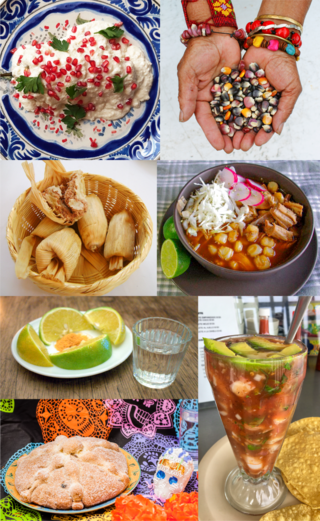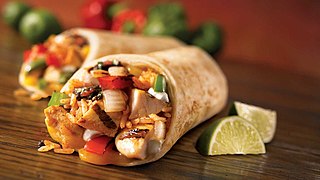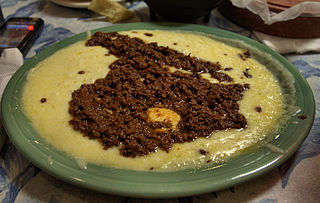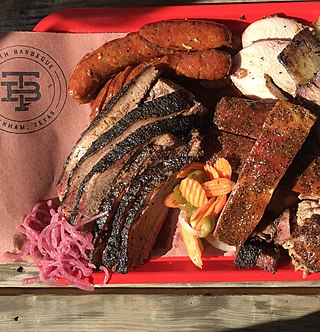
Mexican cuisine consists of the cooking cuisines and traditions of the modern country of Mexico. Its earliest roots lie in Mesoamerican cuisine. Mexican cuisine ingredients and methods begin with the first agricultural communities such as the Olmec and Maya who domesticated maize, created the standard process of nixtamalization, and established their foodways. Successive waves of other Mesoamerican groups brought with them their cooking methods. These included: the Teotihuacanos, Toltec, Huastec, Zapotec, Mixtec, Otomi, Purépecha, Totonac, Mazatec, Mazahua, and Nahua. With the Mexica formation of the multi-ethnic Triple Alliance, culinary foodways became infused.

An enchilada is a Mexican dish consisting of a corn tortilla rolled around a filling and covered with a savory sauce. Enchiladas can be filled with various ingredients, including meats, cheese, beans, potatoes, vegetables, or combinations. Enchilada sauces include chili-based sauces, such as salsa roja, various moles, tomatillo-based sauces, such as salsa verde, or cheese-based sauces, such as chile con queso.

A fajita, in Tex-Mex cuisine, is any stripped grilled meat, optionally served with stripped peppers and onions usually served on a flour or corn tortilla. The term originally referred to skirt steak, the cut of beef first used in the dish. Popular alternatives to skirt steak include chicken and other cuts of beef, as well as vegetables instead of meat. In restaurants, the meat is usually cooked with onions and bell peppers. Popular condiments include shredded lettuce, sour cream, guacamole, salsa, pico de gallo, shredded cheese, refried beans, and diced tomatoes. "Tacos de arrachera" is applied to the northern Mexican variant of the dish.

Chili con carne is a spicy stew of Mexican origin containing chili peppers, meat, tomatoes, and often pinto beans or kidney beans. Other seasonings may include garlic, onions, and cumin.

Nachos are a Tex-Mex culinary dish consisting of tortilla chips or totopos covered with cheese or cheese sauce, as well as a variety of other toppings and garnishes, often including meats, vegetables, and condiments such as salsa, guacamole, or sour cream. At its most basic form, nachos may consist of merely chips covered with cheese, and served as an appetizer or snack, while other versions are substantial enough as a main course. The dish was created by, and named after, Mexican restaurateur Ignacio "Nacho" Anaya, who created it in 1943 for American customers at the Victory Club restaurant in Piedras Negras, Coahuila.

The Original Ninfa's on Navigation is a popular Mexican restaurant located at 2704 Navigation Boulevard in Houston, Texas. The restaurant serves both Tex-Mex and Mexican cuisine. The Original Ninfa's was started by Ninfa Rodríguez Laurenzo, a Mexican-American woman, in a tortilla factory. Ninfa Laurenzo became a full-time restaurateur and the tortilla factory closed. Mama Ninfa is widely credited with popularizing the fajita among Houstonians.

Chili powder is the dried, pulverized fruit of one or more varieties of chili pepper, sometimes with the addition of other spices. It is used as a spice to add pungency (piquancy) and flavor to culinary dishes. In American English, the spelling is usually "chili"; in British English, "chilli" is used consistently.

The cuisine of the Southwestern United States is food styled after the rustic cooking of the Southwestern United States. It comprises a fusion of recipes for things that might have been eaten by Spanish colonial settlers, cowboys, Mountain men, Native Americans, and Mexicans throughout the post-Columbian era; there is, however, a great diversity in this kind of cuisine throughout the Southwestern states.

Chile con queso, sometimes simply called queso, is an appetizer or side dish of melted cheese and chili peppers, typically served in Tex-Mex restaurants as a dip for tortilla chips.

Taco Palenque is a Mexican cuisine restaurant chain in Texas & Nuevo León. The restaurant is headquartered in Laredo, Texas and was established in 2017. The restaurant's main dishes are the flame-grilled beef or chicken fajita plate, parrillada, pirata taco, panchos drizzled with bean and cheese on top of tortilla chips, homemade desserts, and breakfast tacos. Taco Palenque's salad bar has more than 7 different homemade salsas.

A burrito in Mexico is, historically, a regional name, among others, for what is known as a taco, a tortilla filled with food, in other parts of the country. The term burrito was regional, specifically from Guanajuato, Guerrero, Michoacán, San Luis Potosí and Sinaloa, for what is known as a taco in Mexico City and surrounding areas, and codzito in Yucatán and Quintana Roo. Due to the cultural influence of Mexico City, the term taco became the default, and the meaning of terms like burrito and codzito were forgotten, leading many people to create new meanings and folk histories.

Felix Tijerina (1905–1965) was a Mexican-American restaurateur, activist, and philanthropist in Houston, Texas. He served as the 25th president of the League of United Latin American Citizens.

Queso flameado, also known as queso fundido or choriqueso, is a dish of hot melted cheese and spicy chorizo that is often served flambé. Often compared to cheese fondue, it is a party dish; it is popular at cookouts and in restaurants as an appetizer. Almost unique in Mexican cuisine, in the cuisine of the United States this dish has been widely adapted and is considered a native dish in El Paso. In Mexico, it occurs in restaurants more often in the north. Typical main ingredients are melted cheese and a characteristic meat sauce of loose fresh chorizo, tomato, onion, chile and spices. It is served in a small, shallow casserole or other ceramic or metal heat-proof baking dish. The cheese and sauce are prepared separately, and combined just before serving. This may be done at the table, especially if finished with a flambé: high alcohol liquor is poured on the cheese and ignited, and as it burns the server folds in the sauce. If not flambéed, the mixture may be quickly broiled. Either way, the finished dish is presented while it is still bubbling hot, and it is spooned onto small soft tortillas for individual servings.

Texas Barbecue refers to methods of preparation for barbecue unique to Texan cuisine. Beef brisket, pork ribs, and sausage are among the most commonly known dishes. The term can also include side dishes that are traditionally served alongside the smoked meats.

Tex-Mex cuisine is very popular in Houston. Many Mexican cuisine restaurants in Houston have aspects that originate from Texas culture. Katharine Shilcutt of the Houston Press said in 2012 that "Tex-Mex has been a vital part of our city for more than 100 years" and that it "never waned in that century." She added that "[t]he cultural significance of Tex-Mex as a vital touchstone between generations and an expression of our roots cannot be denied."

Texan cuisine is the food associated with the Southern U.S. state of Texas, including its native Southwestern cuisine–influenced Tex-Mex foods. Texas is a large state, and its cuisine has been influenced by a wide range of cultures, including Tejano/Mexican, Native American, Creole/Cajun, African-American, German, Czech, Southern and other European American groups. The cuisine of neighboring states also influences Texan cuisine, such as New Mexican cuisine and Louisiana Creole cuisine. This can be seen in the widespread usage of New Mexico chiles, Cayenne peppers, and Tabasco sauce in Texan cooking.

Mexican-American cuisine is the cuisine of Mexican Americans and their descendants, who have modified Mexican cuisine under the influence of American culture and immigration patterns of Mexicans to the United States.
Josef Centeno is an American chef, restaurateur and cookbook author who specializes in Tex-Mex cuisine. He was nominated for a James Beard award for Best Chef in February 2020.




































